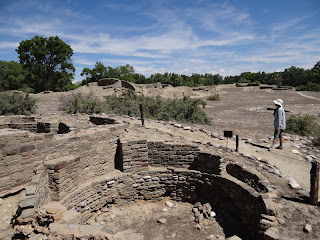Sunday, September 16, 2012
September 11: Catching Salmons
About 12 miles south of Aztec is another Chacoan Great House, Salmon Ruins. The "l" is pronounced because it is a family name, like Solomon. There are no salmon in the San Juan River of New Mexico. However, there were Salmons in Bloomfield, NM, on whose ranch the ruins were located until they sold the land to the San Juan Museum Association in 1969. It was not excavated until the 1970s, although it had long been recognized as a very important Chacoan site.
While visiting the ruins, we camped in Bloomfield at a former KOA.
It was another quiet place, with no other campers nearby and lots of hot water. Unfortunately, the ownership also piped into the restrooms a radio station playing 1960s music. Beach Boys, Roy Orbison, and hot showers. Out of sight.
The museum at the ruins displayed interesting artifacts, as well as rock art from nearby canyons. (Mostly Navajo rock art.) For research purposes, I thought this lizard man/woman fetish found in one of the rooms to be significant.
There was also a display of tchamajillas,
which are ritual fetishes still used today by some Pueblo clans and societies.
(This trip is supererogatorily providing me with a lot of new big vocabulary words, like tchamajillas, latillas, taphonomic, and laccolithic.)
Archaeologists are agreed (when has that ever happened before?) that Salmon was established in the 1080s as a little "Chaco" by an elite group down the road from Chaco. A straight road is still visible that once led from Chaco Canyon to Salmon.
It was 30-feet wide and cleared of all stones, even though native Americans had not yet "discovered" the wheel. These roads were probably ceremonial procession and trade routes--as in all roads lead to Chaco.
We were again pleased that the ruins involved a self-guided tour and allowed us to roam as we wished. (Within limits of course.) We were also pleased that the admission was only $2 per person, since it was not covered by our Senior National Park Pass.
Salmon is large, over 250 rooms
and it was built as a Chacoan Great House.
Its north wall
is about 450 feet long. Its early masonry shows characteristic Chaco banded stonework.
The small kivas (or "round rooms" as Stephen Lekson calls them) were built inside square rooms,
a Chaco creation. (They wanted to show how to fit a round hole in a square peg.)
Like Chetro Ketl at Chaco, the center of the building had a multistoried "tower kiva."
This was heavy duty ceremonial space,
and adjacent rooms had altars and religious paraphernalia in them. However, the exact purpose of tower kivas has never been figured out. Again, there was a large "Great Kiva" in the plaza facing the Great House.
On the way out of the ruins, in the shadow of the Salmon ranch,
we visited the entertaining outdoor exhibit that had been set up to educate children on the evolution of Native American cultures. There was a pithouse, a wickiup, a teepee, a hogan (female and male, no less!), and a ramada work camp. There was also a nasty cactus.
Watch out for this species of cactus when taking photographs of an imitation hogan at parks. I spent the better part of an hour pulling tiny spines out of my leg. It must be called a porcupine cactus. We had met it before, but I am a slow learner.
The little educational park even had an imitation kiva, complete with fake pueblo rooms from Pueblo II phase.
We could almost picture boy scouts and girl scouts sitting on their hands watching the matrons of Bloomfield perform Hiawatha. It was inspirational, although it was Iroquois.
Subscribe to:
Post Comments (Atom)
















No comments:
Post a Comment